The University of Manchester, UK, led by Professor Albert Zylstra, has made a groundbreaking discovery regarding the temperature of stars in our galaxy. They have found that there are stars with incredibly low temperatures. In fact, one star in particular has a surface temperature that reaches as low as 2-3 thousand Kelvin.
When it comes to measuring the temperature of stars, one of the easiest methods is to observe their color. Similar to how red-hot metal changes color depending on its heat, stars also display different colors based on their temperature. Astronomers use an absolute temperature scale, similar to the Celsius scale, but with a shift at the beginning. This scale, known as kelvin, has a step of one kelvin (1 K) which is equivalent to one degree Celsius (1 °C). The zero point on this scale is set at -273 (0 K = -273 °C).
The hottest stars, with temperatures reaching up to 200,000°C, are characterized by a blue and white color. Stars that are less hot have a yellowish hue, while cold stars appear reddish. It is interesting to note that even the coldest stars have a temperature of 2-3 thousand Kelvin, which is still hotter than any molten metal.
The color of a star can only be roughly perceived by the human eye. To obtain more precise measurements, we utilize photographic and photoelectric radiation detectors that are sensitive to various regions of the visible (or non-visible) spectrum. This is because the color of a star is influenced by the part of the spectrum with the greatest amount of radiant energy. By comparing the magnitudes of stars in different spectral intervals (such as blue and yellow), we can quantitatively describe the star’s color and estimate its temperature.
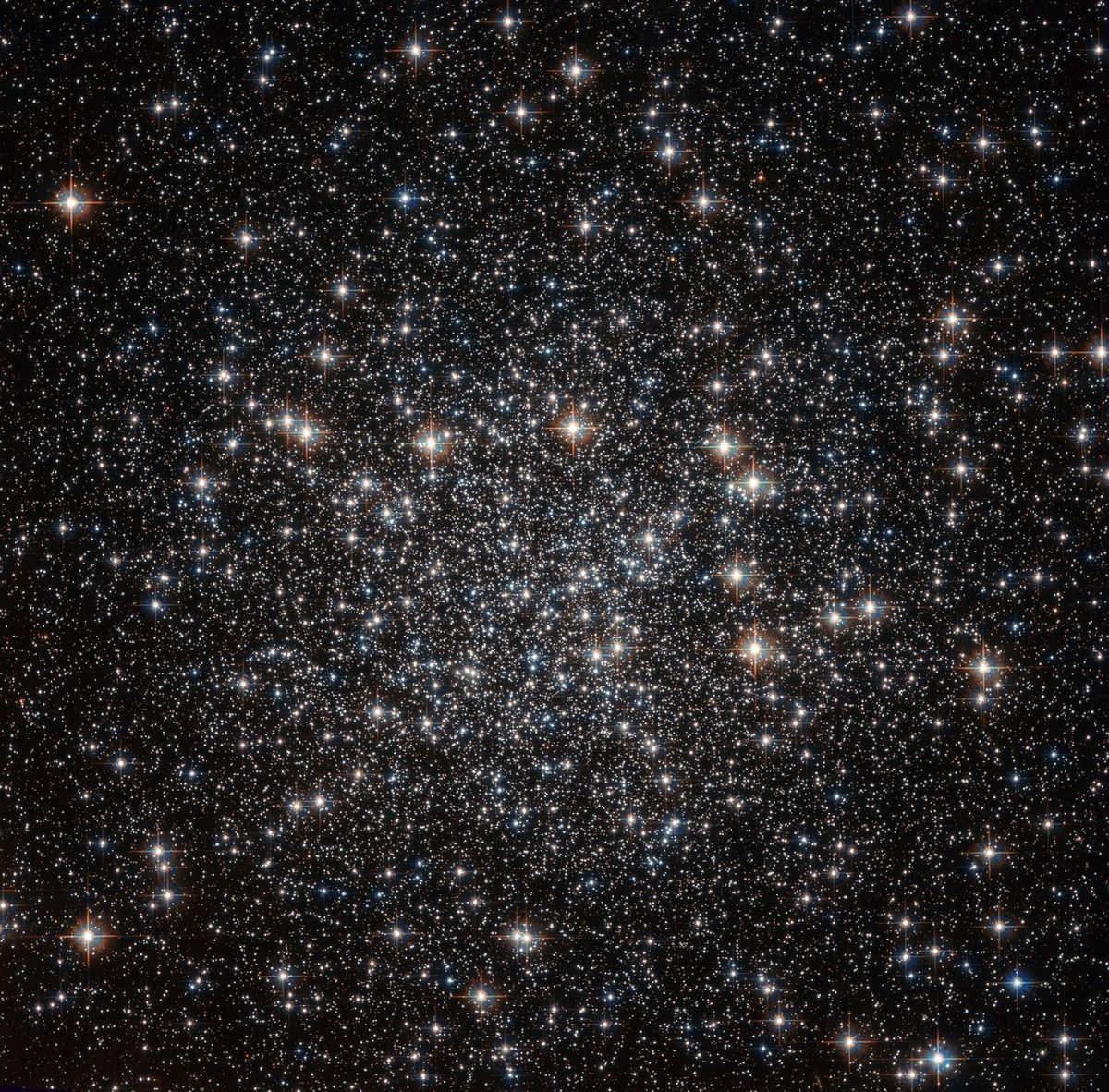

How do we go about determining the temperature of stars? The straightforward answer would be to use a thermometer. However, this approach does not hold true when it comes to stars. Stars can reach temperatures in the thousands of Kelvin, which no thermometer can handle. Even if a superpowered thermometer were to exist, it would still be impractical to use on stars that are millions of light years away. So, how then do we measure the temperature of stars?
This is where indirect methods come into play. In order to overcome these challenges, astrophysicists employ a variety of indirect techniques to measure temperature. Let’s explore some of these methods!
Wien’s Law of Displacement
Wien’s Law of Displacement states that the wavelength at which the intensity of radiation from a black body is maximum is inversely proportional to the temperature of the body. In simpler terms, as the temperature of a black body increases, the peak of its radiation spectrum shifts to shorter wavelengths. This law is important in understanding the behavior of black bodies and how they emit and absorb radiation.
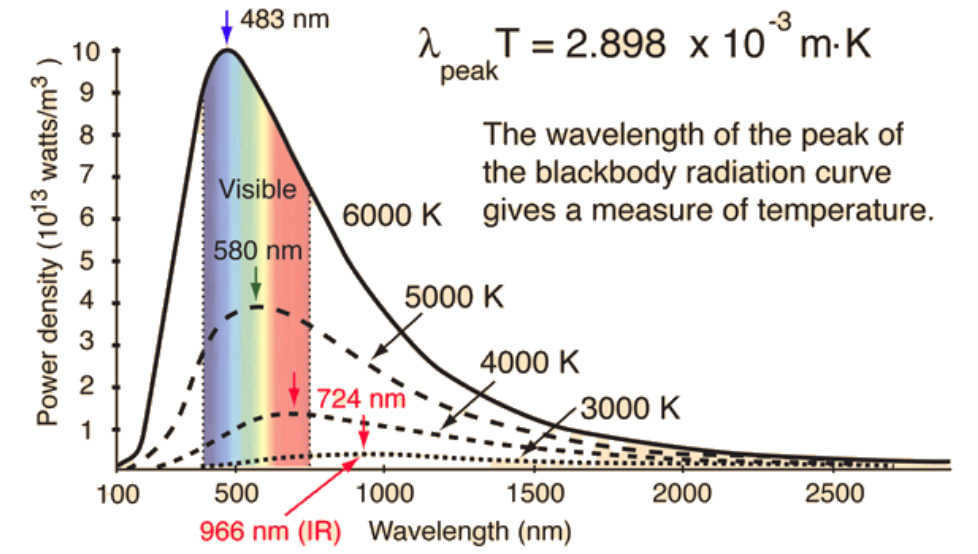
Wien’s displacement law is concerned with the spectrum of blackbody radiation. It states that the peak wavelength of the radiation curve for different temperatures is inversely proportional to the temperature. By using this relationship between wavelength and temperature, we can estimate the temperatures of stars.
However, this method is only applicable to stars that have spectra very similar to the blackbody spectrum. Additionally, we need to have spectra calibrated to the flux of the specific star. It’s important to note that this method may not provide highly accurate results because stars are generally not black bodies.
Stefan-Boltzmann Law
The Stefan-Boltzmann Law is another principle that can be utilized to determine the temperature of celestial bodies. It outlines the amount of radiant energy emitted by a black body based on its temperature. As per this law, the total heat energy radiated by a surface is directly proportional to the fourth power of its absolute temperature. The equation is expressed as L = 4πR 2 σT 4. In this equation, σ represents the Stefan-Boltzmann constant, L denotes the luminosity, and R and T stand for the radius and temperature of the star being studied.
We begin by measuring the overall light output of the star. By combining these variables, researchers can calculate the brightness. By utilizing interferometers, they are able to ascertain the size of the star. Ultimately, temperature is determined by incorporating all of these variables into the Stefan-Boltzmann equation. The main challenge lies in accurately measuring the radii of the largest or closest stars. As a result, measurements are only available for a handful of massive stars and a small number of nearby main-sequence stars. However, these measurements serve as essential benchmarks against which astronomers can compare and calibrate other techniques.
Through the utilization of spectral analysis on a celestial body.
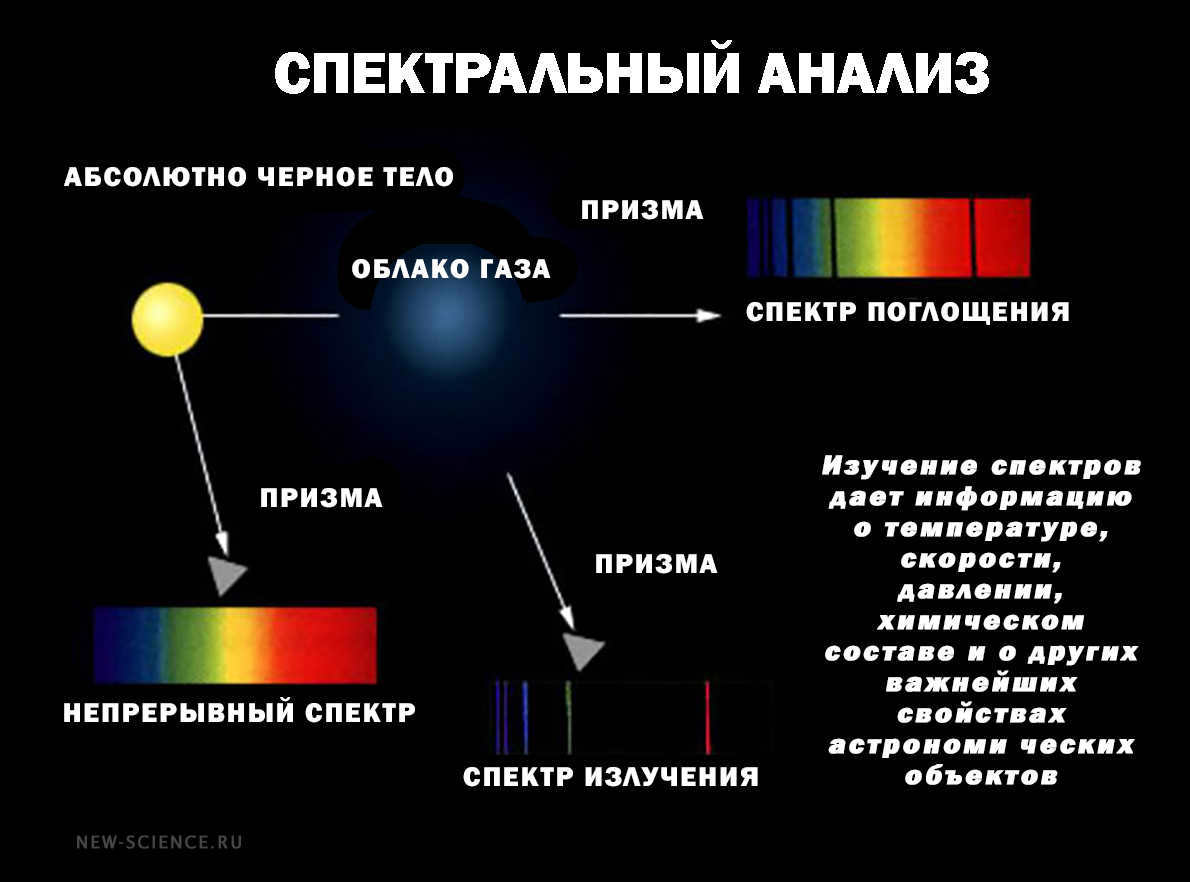
It is common knowledge that atoms and ions possess varying energy levels. The distribution of these levels is influenced by temperature, with higher temperatures favoring occupation of higher levels and vice versa for lower temperatures. As a result, transitions between levels can give rise to the emission or absorption of light at specific wavelengths, determined by the energy difference between the respective levels. In general, the interior of a star is hotter than its exterior. The cooler outer layers of the star absorb radiation emitted from its core, leading to the presence of absorption lines in the observed spectrum.
The process of spectral analysis involves the measurement of the intensity of absorption lines at various wavelengths for different chemical elements. The intensity of these lines is primarily determined by the temperature of the star and the concentration of a specific chemical element. However, other factors such as gravity, turbulence, and atmospheric structure can also influence the intensity. By using this method, temperature can be measured with a precision of +/-50 Kelvin.
Correlation between color and temperature
An alternative approach to gauging the temperature of stars is through examination of their color. While stars may appear white at a glance, closer inspection reveals a range of hues. These variations in color are directly linked to the star’s temperature, with colder stars appearing red and hotter stars displaying a blue hue. To determine the color of a star, scientists employ a specialized tool known as a photoelectric photometer.
This device utilizes various filters to analyze the amount of light that passes through each one. By converting these photometer measurements into temperature values using standardized scales, researchers can accurately estimate the star’s temperature, with a margin of error of approximately +/- 100-200 K. This method proves particularly useful in cases where a comprehensive spectrum of the star is not readily available. However, its efficacy diminishes when applied to cooler stars, yielding less precise results in such instances.
Each of the aforementioned methods has its own set of advantages and disadvantages. However, astrophysicists worldwide extensively utilize these methods and ultimately yield satisfactory outcomes.
The blackbody radiation laws (see § 6) can be employed to determine the temperature of a star. The most straightforward approach to measuring a star’s temperature is to assess its color. It is worth noting that only the color of luminous stars can be discerned with the naked eye, as our eyes are not very sensitive to perceiving colors in low light conditions. The color of dim stars, on the other hand, can be determined using binoculars or a telescope, which gather more light and make stars appear brighter when viewed through the eyepiece of a telescope.
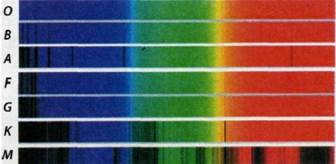
Figure 13.3 The 7 major spectral classes determine the colors of stars. Stars with the lowest temperature belong to spectral class M, while stars with the highest temperature are in spectral class O. The Sun, which has a photosphere temperature of +5780 K and a yellow color, belongs to spectral class G.
Spectral class O consists of blue stars that have the highest surface temperature and emit more energy in the blue part of the spectrum (Fig. 13.4). Each spectral class is further divided into 10 subclasses, ranging from AO to A9.
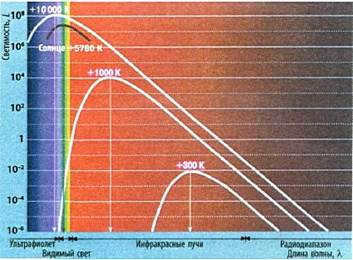
Figure 13.4 illustrates the radiation intensity of cosmic bodies with varying temperatures. Hot stars emit a greater amount of energy in the blue section of the electromagnetic spectrum, while cold stars emit more energy in the red section. Planets primarily emit energy in the infrared section of the spectrum.
Typically, the spectrum of every star contains dark absorption lines, which are formed in the rarefied atmospheres of the star itself and the Earth’s atmosphere. These lines provide information about the chemical composition of these atmospheres. It has been discovered that all stars have nearly identical chemical compositions, as the main elements in the universe are hydrogen and helium. The main distinction among different spectral classes of stars is mainly due to the temperature of their photospheres.
In order to ascertain the radius of a star, the geometric method proves ineffective due to the vast distance between stars and Earth. Until recently, even with the aid of large telescopes, measuring their angular size was an impossible feat as all stars appeared as identical, luminous points. To determine the radius of a star, astronomers rely on the Stefan-Boltzmann law:
The energy emitted by a star’s surface per unit of time, denoted as Q, can be calculated using the Stefan-Boltzmann constant, σ, and the absolute temperature of the star’s surface, T.
The power emitted by a star with a radius of R is determined by its surface area.

Conversely, we have the ability to express the identical correlation with regards to the energy emitted by the Sun:
Hence, by using Equations 13.8 and 13.9, we are able to ascertain the elusive magnitude of the star’s radius provided that we are already aware of the radius and temperature of the Sun:

The luminosity of a star, denoted as L, is measured in units relative to the Sun’s luminosity.
Scientists have discovered that there exist stars with radii hundreds of times greater than the radius of the Sun, as well as stars with radii smaller than the Earth’s radius (Fig. 13.5).

Figure 13.5: Radii of various stars in comparison to the Sun
The temperature of a star can be calculated using the principles of blackbody radiation (refer to Section 6). The simplest approach to determining the temperature of a star is by analyzing its color. It is important to note that the human eye can only discern the colors of bright stars, as our ability to perceive colors in low light conditions is significantly reduced. However, the color of faint stars can be determined with the use of binoculars or a telescope, which gather more light, allowing stars to appear brighter when observed through the eyepiece of a telescope.

According to Figure 13.3, the temperature of stars determines their colors and is categorized into 7 major spectral classes. Stars that belong to spectral class O are the hottest and have a blue color, while stars in spectral class M are cooler and have a red color. The Sun, with a photosphere temperature of +5780 K and a yellow color, falls under spectral class G.
It is worth mentioning that blue stars in spectral class O have the highest surface temperature and emit more energy in the blue part of the spectrum, as depicted in Figure 13.4. Furthermore, each spectral class is further divided into 10 subclasses, such as AO, A1..A9.

Figure 13.4 illustrates the variation in radiation intensity across different temperatures of cosmic bodies. Hot stars emit a greater amount of energy in the blue part of the spectrum, while cold stars emit a greater amount of energy in the red part. Planets, on the other hand, primarily emit energy in the infrared part of the spectrum.
Typically, the spectrum of each star contains dark absorption lines, which form in both the star’s rarefied atmosphere and the Earth’s atmosphere, providing insights into the chemical composition of these atmospheres. It has been discovered that all stars possess a nearly identical chemical composition, as hydrogen and helium are the predominant elements in the Universe. The main distinguishing factor among different spectral classes is the temperature of the stellar photospheres.
In order to calculate the radius of a star, the geometric method is not applicable due to the vast distances between stars and Earth. Even with the aid of large telescopes, measuring the angular size of stars has historically been unfeasible, as they all appear as bright points. Instead, astronomers rely on the Stefan-Boltzmann law to determine the radius of a star:
The amount of energy emitted by a star’s surface per unit of time, denoted as Q, can be calculated using the Stefan-Boltzmann constant, σ, and the absolute temperature of the star’s surface, T.
The total power radiated by a star with a radius of R is determined by the surface area of the star, which can be expressed as:

Conversely, we can express the power emitted by the Sun using a similar equation:
Therefore, if we know the temperature of the Sun and the radius, we can use Equations 13.8 and 13.9 to calculate the unknown radius of the star:

Regarding the luminosity of stars, the symbol L represents the luminosity of the star in comparison to the Sun’s luminosity.
Research has shown that there exist stars with a radius hundreds of times greater than the Sun’s radius, as well as stars with a radius smaller than the Earth’s radius (Fig. 13.5).

Figure 13.5: Comparison of the sizes of different stars with that of the Sun
It is common knowledge that stars have extremely high temperatures inside them. This high temperature is what triggers thermonuclear reactions. When a molecular cloud is compressed by gravitational forces, it undergoes heating, which continues to increase as the mass of molecules increases. This leads to the synthesis of helium from hydrogen, or in simpler terms, the birth of a star.
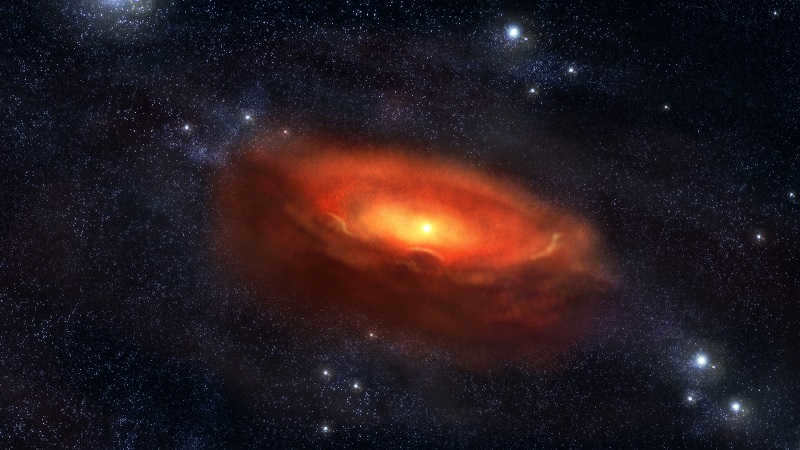
Despite hydrogen molecules being the building blocks of all clouds, variations in the number of hydrogen particles result in differences in their masses, leading to the formation of different protostars. Although the process of star formation is generally similar.
Primarily, stars experience an increase in temperature during their initial formation and later during the reactions occurring in their core. Consequently, the heat generated in the central region of the star ascends to its outer layers, also known as the surface. As the internal composition varies across different celestial bodies, so does the temperature on their surfaces.
It should be highlighted that the heating of the celestial body from within and without is not identical. It is intriguing to observe that the outer layer of the atmosphere, known as the stellar corona, is considerably hotter than the lower atmospheric regions. However, it goes without saying that the highest temperature is generated by nuclear fusion.
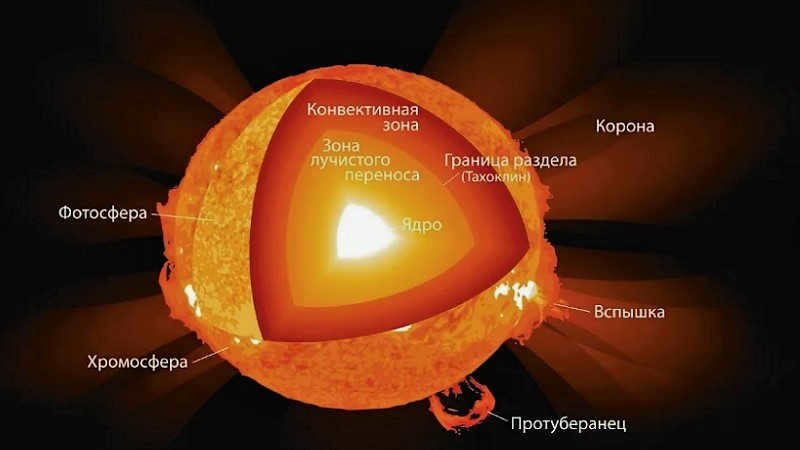
The Factors that Determine the Temperature of a Star
The temperature of a star is influenced by two primary factors.
Firstly, it is determined by the amount of energy generated by the core. According to scientists, the core heats up to 15 million degrees Celsius. However, only the heat from thermonuclear reactions is emitted. The energy resulting from gravitational compression remains trapped in the center.
The surface temperature of stars is directly influenced by the intensity of internal processes and the elements involved in them. For instance, if there is a synthesis of not only helium from hydrogen, but also the synthesis of heavy elements, the radiative energy will be significantly higher. Consequently, the surface will be heated to a greater extent.
Secondly, the crucial factor is the surface area that emits internal energy. The key idea is that celestial objects generate and simultaneously release energy into the surrounding space. The amount of energy they emit depends on the external layer, which is the radiating surface.
As stars enlarge their outer shell, their core also expands. The denser it becomes, the hotter it gets. However, this only applies internally, as stars of this kind have a low temperature in their photosphere (the outer layer). In simpler terms, the larger the area, the higher the energy output.
Furthermore, there exists a correlation amongst the dimensions, weights, brightness, and temperatures of celestial entities. To illustrate, the greater the mass of a stellar entity, the greater its luminosity, and consequently its warmth. It is noteworthy that the temperature of a star dictates its hue. The correlation between the attributes of celestial bodies is depicted in the Hertzsprung-Russell plot.
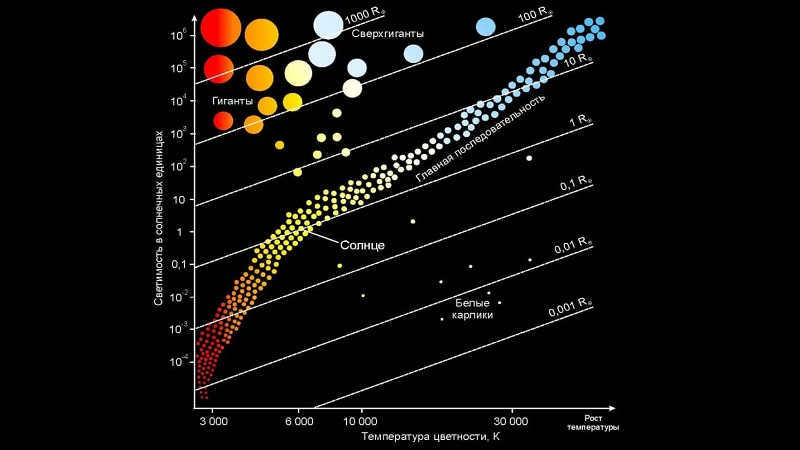
The Hertzsprung-Russell diagram displays the differences in spectral classes, which are characterized by a set of distinct features.
How to calculate the temperature of stars
It is important to note that the temperature of stars is determined using the effective heating value of the object. Essentially, the hotter an object is, the more energy it emits. In the case of stars, their brightness is a measure of their incandescence.
The effective temperature of stars is determined using the Stefan-Boltzmann law. This law states that the radiation power of a heated object is directly proportional to its surface area and the fourth power of its temperature.
Where σ is a constant factor of 5.7*10-8,
S is the area, and P is the radiated power.
In fact, the temperature of stars is defined in Kelvin (K). It is true that it can be converted to degrees Celsius (C).
What are the possible surface temperatures of stars?
Scientists have estimated that the surface temperatures of individual stars can vary. Cooler stars have temperatures ranging from 2000 to 5000 K, while the average temperature for yellow and orange bodies is between 5000 and 7500 K. The hottest stars can reach temperatures as high as 7500-80000 K.
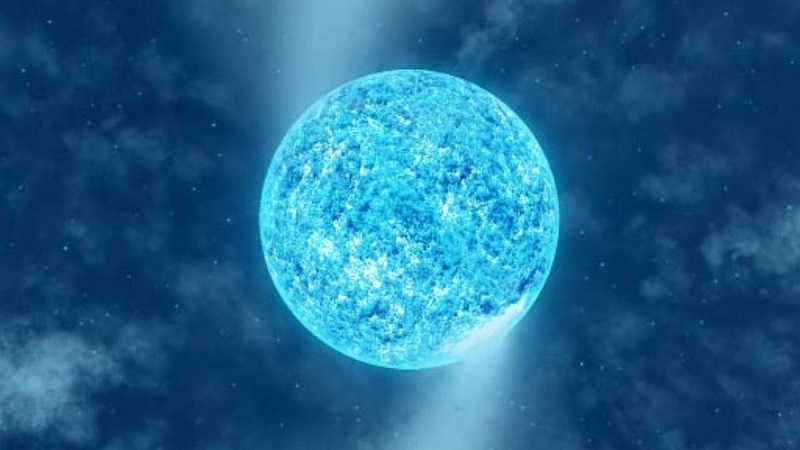
Naos (the hottest star)
Stars with the lowest temperature
The stars with the lowest surface temperature are the ones that appear red in color. However, it wouldn’t be entirely accurate to describe them as cold, since their temperature still ranges between 2000-3000K.
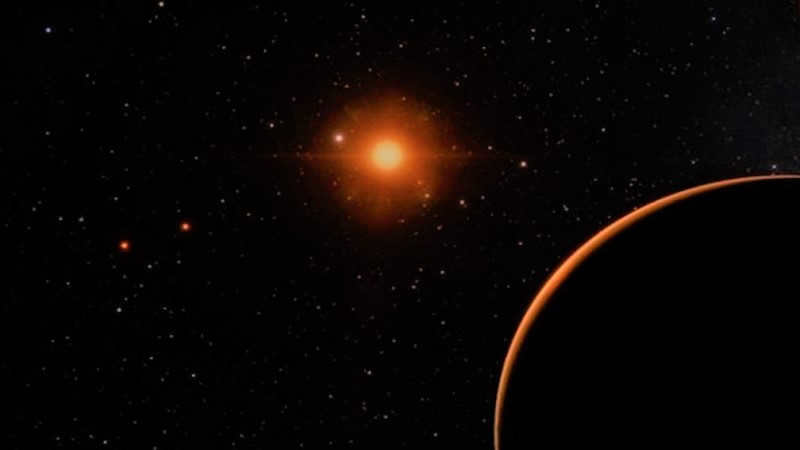
Barnard’s star (one of the coldest stars)
Which type of star has the highest temperature
What do you think is the surface temperature of the hottest stars?
By the way, the hottest luminaries are blue or white in color. The blue ones have the highest levels, though. Just think about it, their heat levels can be as high as 40000K.
So we have acquired knowledge that stars can have varying temperatures and sizes. Moreover, their characteristics are interrelated.
It is also evident that the temperature at the core of a star differs from the surface temperatures they can possess. This once again demonstrates the uniqueness of each celestial object. Even if certain properties resemble those of other bodies, there will inevitably be a discrepancy in some other parameter.
When we talk about stars, we are usually referring to celestial bodies that are extremely hot. These stars have incredibly high temperatures, with some reaching temperatures in the tens and hundreds of thousands of degrees. Even the surface of the Sun, which is the closest star to us, has a temperature of 6000 degrees, but it can be considered only mildly heated compared to the “torches” of the Universe. White dwarfs, for example, have temperatures of 200,000 degrees.
It may be hard to believe, but there are stars that are actually much colder than the Sun. These stars are known as brown dwarfs, and we will discuss them further in chapter 7.
Once upon a time, there was a star known as CFBDS0059 that held the record for its unique temperature. According to various sources, this star’s temperature ranged from 180 to 350 degrees Celsius, which is comparable to the freezing temperatures of Earth’s Antarctica.
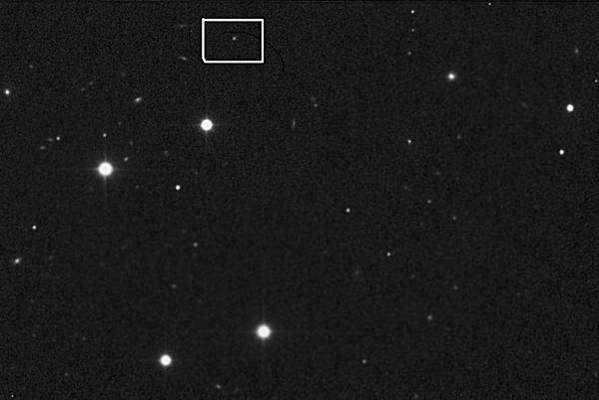
A celestial object located in the constellation of Volopasa is known as a brown dwarf.
Astronomers have given the name “brown dwarfs” to stars with extremely low temperatures. These objects fall into a unique category, as they exist in an intermediate state between stars and planets. During their early stages of evolution, brown dwarfs function as stars. However, as they age, they transition into a planet-like group, similar to giant planets such as Jupiter.
According to the widely accepted theory of stellar structure and evolution, it is postulated that a celestial body will become a sun if its mass reaches 80 times that of Jupiter. This is because at a lower mass, the star will not be able to sustain thermonuclear reactions that provide it with the necessary energy.
For a brown dwarf to form, it is sufficient for the celestial object to have a mass equal to 13 times that of Jupiter. This is relatively small in cosmic terms.
Since 1995, when the existence of these cosmic bodies was confirmed through actual research, over a hundred have already been discovered. Scientists have categorized them into two groups: the hotter dwarfs belong to the L-class, while the cooler ones belong to the T-class.
However, the recent discovery of the cold star CFBDS0059 defies traditional classification and requires its own separate category – the Y-class.
With a mass ranging from 15 to 30 times that of Jupiter, this star is situated 40 light-years away from Earth. Its most distinctive feature is its incredibly low temperature, resulting in a faint luminosity and predominantly infrared radiation.
Nevertheless, it didn’t take long before astronomers stumbled upon an even colder brown dwarf in 2011. Utilizing a ten-meter telescope located on the island of Mauna Kea, they managed to detect this celestial object, despite its incredibly weak signal that was easily drowned out by the surrounding cosmic noise.
A newly discovered brown dwarf has been designated as CFBDSIR J1458+1013B. Unlike previously discovered brown dwarfs, this one is part of a binary system. Its companion is also a brown dwarf, but of a more typical variety. This system is located approximately 75 light years away from Earth.
The temperature of this remarkable new brown dwarf ranges from about 60 to 135 degrees Celsius. This suggests that it may contain liquid water.
While the presence of hot water vapor has been detected in the atmospheres of other brown dwarfs in the past, scientists believe that on this extremely cold dwarf, water may even exist in the form of clouds.
This passage serves as an introductory excerpt.
More to Explore
The Curious Case of Chilly Ears
Did you know that everyone, regardless of their intelligence, experiences slightly cooler ear temperatures compared to their body? This phenomenon has puzzled scientists for years.
When Toes Turn Frosty
Many parents worry when their little ones have cold hands and feet, even in warm environments. But fear not! Experts explain why this is a common occurrence and provide reassurance for concerned caregivers.
Cold Feet
Some parents often become anxious when their young children, despite being kept warm (and even overly warm), have chilly hands and feet. This can cause concern for both the parents themselves and for various “advisors” such as grandparents, relatives, and acquaintances.
Paradox
Paradox (para-dokew-appear) – a viewpoint that deviates from the commonly accepted belief. A paradoxical statement can reflect either a true or a false opinion, depending on what is generally acknowledged. Many authors exhibit a tendency towards making paradoxical statements, which often characterizes their style of writing.
Paradoxical Elements in Music
Exploring the Paradox and Banality
Paradox and banality often go hand in hand, especially in the realm of music. A paradox can be defined as a logical statement that highlights the absurdity of reality. Take, for example, the case of Henrik Jagodziński, a renowned Polish satirist born in 1928. His work embodies the paradoxical nature of our world. Similarly, Wladyslaw Grzegorczyk, a Polish aphorist, once stated that a paradox represents two seemingly contradictory truths that coexist. It is through these paradoxes that we embark on the journey towards truth, as eloquently expressed by Oscar Wilde (1854-1900).
PARADOX
PARADOX An illogical statement about a contradictory reality. Henrik Jagodzinski We use paradoxes to highlight the difficulty of finding meaningful truths. Jean Condorcet Any precise description of the world will inevitably lead to a paradox. Stanislaw Jerzy Lecz A paradox exists.
Our sun emits a pale yellow light. Normally, stars display a mesmerizing array of colors. A specific group of stars is referred to as “The Jewel Box.” Within this constellation, you can observe sapphire and blue stars scattered across the dark expanse of the night sky. Surrounded by these stars, in the center of the constellation, shines a brilliant orange star.
Differences in star color
The variation in color among stars can be attributed to their varying temperatures. Let’s explore the science behind this phenomenon. Light is a form of wave radiation, with the distance between wave crests known as its wavelength. When it comes to light waves, they are incredibly short. To put it into perspective, imagine dividing an inch into 250,000 equal parts (1 inch is equivalent to 2.54 centimeters). A light wavelength would only encompass a few of these tiny divisions.
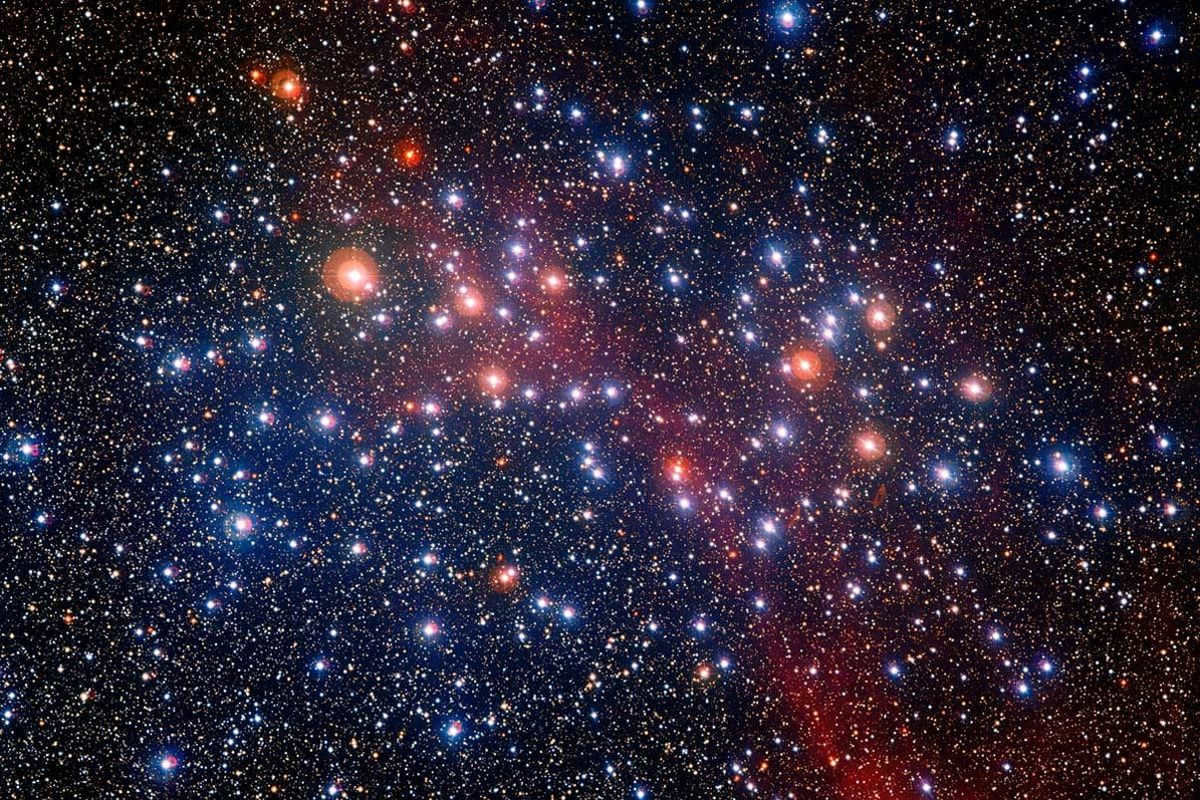
Even though the size of light waves is incredibly small, the slightest variation in their size can have a significant impact on the color of the image we perceive. This is because our brains interpret light waves of different wavelengths as different colors. For instance, the wavelength of the color red is one and a half times longer than the wavelength of the color blue. When combined, these different-colored light waves create white light.
The stars that we observe come in a variety of colors and luminosities. The brightness of a star is determined by its mass and its distance from us, while the color of a star is determined by its surface temperature. The coldest stars appear red in color, while the hottest stars appear bluish. The hottest stars, such as white and blue stars, have a higher temperature than our Sun. Speaking of our Sun, it is classified as a yellow star.
How many stars are there in the sky?
Estimating the exact number of stars in the observable universe is an extremely challenging task. Scientists can only provide an approximate figure for the number of stars in our own galaxy, the Milky Way, which is believed to contain around 150 billion stars. However, it is important to note that there are numerous other galaxies in the universe. On a more localized scale, astronomers have a much more accurate count of the stars visible to the naked eye from Earth’s surface. It is estimated that there are approximately 4,500 stars that can be seen without the aid of a telescope.
What is the process of star formation?
Is there a desire for stars to be illuminated? Within the vast expanse of cosmic space, hydrogen molecules, the simplest substance in the universe, are always present. The distribution of hydrogen varies, with some regions containing less and others containing more. Through the force of mutual attraction, these hydrogen molecules come together, and this attraction can persist for millions or even billions of years. Eventually, the hydrogen molecules become so close to each other that they form a gas cloud. As the attraction continues, the temperature at the center of the cloud begins to rise. Over millions of years, this temperature can reach a point where a fusion reaction occurs, transforming hydrogen into helium and giving birth to a new star in the sky. Every star is essentially a luminous ball of gas.
The lifespan of stars can vary significantly. Scientists have discovered that the duration of a star’s life is inversely related to its mass at birth. Stars can exist for hundreds of millions to billions of years.
What is a light-year?
A light-year is the distance covered by a beam of light in one year, while traveling at a speed of 300,000 kilometers per second. In a year, there are 31,536,000 seconds. Therefore, from the nearest star to us, known as Proxima Centauri, it takes more than four years (4.22 light-years) for light to reach us. This star is 270,000 times farther away from us than the Sun. Other stars are even more distant, ranging from tens to millions of light-years away. This is why stars appear as tiny dots to us, even when observed through powerful telescopes, unlike planets.
What does the term “constellation” mean?
Throughout history, humans have gazed up at the stars and interpreted the patterns formed by groups of bright stars as various animals and mythical heroes. These patterns in the sky are known as constellations. However, it’s important to note that while the stars within a constellation may appear close to each other in the sky, they can actually be quite far apart in outer space. Some of the most well-known constellations include the Big Dipper and the Little Dipper. The Little Dipper is particularly notable because it contains Polaris, the star that marks the North Pole of our planet Earth. By locating Polaris in the night sky, travelers and navigators can easily determine which direction is north and orient themselves accordingly.
Supernovae
There are stars that, at the end of their lifespan, suddenly become thousands and millions of times brighter than usual and release massive amounts of matter into space. This event is commonly referred to as a supernova explosion. Over time, the brightness of the supernova fades, leaving behind a luminous cloud in place of the star. Ancient astronomers in the Near and Far East observed a similar supernova explosion on July 4, 1054. The fading of this supernova lasted for 21 months. Today, many astronomy enthusiasts know this location as the Crab Nebula.
To summarize, it is important to mention that
The primary classification system for stars is based on their spectral characteristics.
Brown dwarfs, a type of star where nuclear reactions have never been able to offset energy loss due to radiation, were previously just a concept. They were theorized in the 20th century based on our understanding of star formation processes. However, in 2004, the discovery of the first brown dwarf confirmed their existence. Since then, a significant number of these stars have been found. They are classified as M – T in terms of their spectral class, with a theoretical additional class denoted as Y.
Red giants and supergiants are celestial bodies that possess relatively low effective temperatures (3000 – 5000 K), yet exhibit immense luminosity. These objects typically have an absolute stellar magnitude ranging from -3m to 0m (I and III luminosity classes). Their spectral composition is distinctive due to the presence of molecular absorption bands, and they emit predominantly in the infrared range.
A variable star refers to a star that has experienced a change in its brightness at least once in the entire history of observation. There are numerous factors that contribute to variability, and they can be attributed to both internal and external processes. For instance, if a star is part of a binary system and the line of sight lies or is at a slight angle to the field of view, one star passing through the other’s disk can cause it to appear brighter. Additionally, the luminosity of a star can change if its light passes through a strong gravitational field. However, in most cases, variability is a result of unstable internal processes. The most recent edition of the general catalog of variable stars classifies them into the following categories:
Eruptive variable stars – These are stars that display changes in their brightness due to violent processes and outbursts in their chromospheres and coronae. The fluctuations in luminosity usually occur as a result of changes in the star’s envelope or mass loss through stellar winds of varying intensity, and/or interactions with the interstellar medium.
Pulsating variable stars – These are stars that exhibit periodic expansions and contractions of their surface layers. Pulsations can be either radial or non-radial. Radial pulsations maintain the star’s spherical shape, while non-radial pulsations cause the star to deviate from a spherical shape, with neighboring zones displaying opposite phases.
Rotating variable stars – These are stars that have an uneven distribution of surface brightness and/or a non-ellipsoidal shape, causing their variability to be observed as they rotate. The uneven surface brightness can be caused by the presence of spots or temperature and chemical variations resulting from magnetic fields whose axes do not align with the star’s rotation axis.
Cataclysmic (explosive and nova-like) variable stars – The variability of these stars is triggered by explosions, which occur either on the star’s surface (novae) or deep within its interior (supernovae).
Eclipse-double systems.
Optical variable double systems with hard X-ray emission
New types of variables – These are variable stars that have been discovered during the catalog publication process and are not yet classified into existing categories.
A cataclysmic variable is a type of star that exhibits a different pattern of luminosity compared to supernovae. While supernovae have a sharp change in luminosity, cataclysmic variables have a more gradual change. However, the amplitude of the change can still be significant, up to 9 magnitudes. In the days leading up to the maximum luminosity, the star is only 2 magnitudes fainter. The classification of a cataclysmic variable depends on the number of days before the maximum luminosity:
– If this time (referred to as t2) is less than 10 days, the star is classified as a “very fast” cataclysmic variable.
– If the time is between 10 and 11 days, the star is classified as a “fast” cataclysmic variable.
– If the time is more than 11 days, the star is classified as a “blue supergiant” cataclysmic variable.
Development
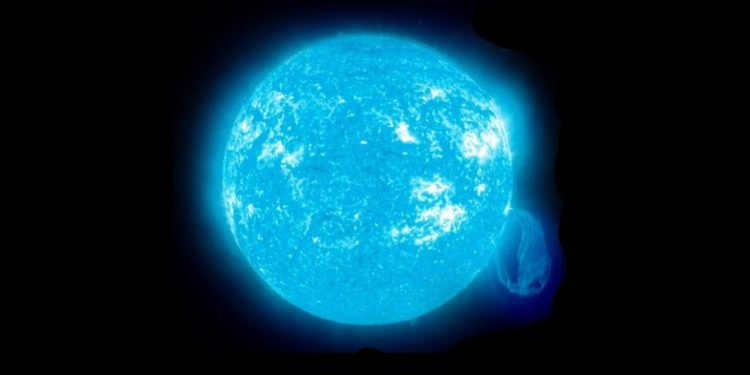
Supergiant Transformation
Supergiants go through a remarkable transformation as they progress through their lifecycle. Blue supergiants, in particular, are massive stars that find themselves in a unique phase of the “dying” process. During this phase, the intensity of thermonuclear reactions in the star’s core begins to decrease. This decrease in intensity causes the star to undergo compression. The compression results in a significant decrease in surface area, which, in turn, causes the density of radiated energy to increase. As a consequence of this increase in energy density, the surface of the star heats up. What’s fascinating is that this compression process can actually cause a red supergiant to transform into a blue supergiant. And, interestingly enough, the reverse process is also possible, whereby a blue supergiant can transform back into a red supergiant.
The stellar wind emitted by a red supergiant is dense and sluggish, whereas the wind from a blue supergiant is swift but sparse. When the compression transforms a red supergiant into a blue supergiant, the faster wind collides with the previously emitted slow wind, resulting in the consolidation of the ejected material into a thin shell. The presence of such a shell in nearly all observed blue supergiants serves as confirmation that they were all once red supergiants.
Because red supergiants are often massive stars, they are more frequently observed than blue supergiants. As a result, the majority of supernovae come from red supergiants. In fact, astrophysicists used to believe that all supernovae originated from red supergiants. However, the formation of supernova SN 1987A from a blue supergiant proved this assumption to be wrong. This event also prompted a reevaluation of certain theories regarding stellar evolution.
Instances of blue supergiants
Rigel
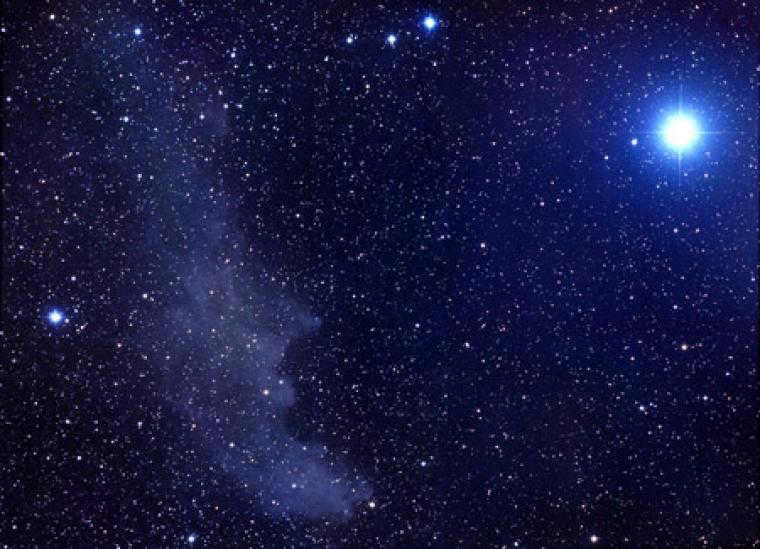
A well-known example is Rigel (beta Orionis), the most luminous star in the Orion constellation. Rigel has a mass approximately 20 times that of the Sun and a luminosity around 130,000 times greater than the Sun, making it one of the most powerful stars in the Milky Way galaxy. It is also the brightest star in the sky with such a high luminosity. In ancient Egyptian mythology, Rigel was associated with Sah, the king of stars and the patron of the dead. Later, it was associated with Osiris.
Gamma Sails is a star group located in the Sails constellation and is considered the brightest among them. It has an apparent magnitude of +1.7m. The estimated distance to the stars within this system is around 800 light-years. Gamma Sails, also known as Regor, is an enormous blue supergiant with a mass equivalent to 30 times that of the Sun. In terms of size, it has a diameter 8 times larger than our Sun. The luminosity of Regor is an astonishing 10,600 times that of the Sun. What makes this star unique is its extraordinary spectrum, which consists of bright emission lines instead of the usual dark absorption lines. It is because of this distinctive feature that it has earned the nickname “Spectral Gem of the Southern Sky.”
Alpha Giraffe.
The Alpha Giraffe is a unique creature that stands out from the rest of the animal kingdom. With its long neck and graceful movements, it is truly a sight to behold. This majestic creature is not only beautiful, but it is also intelligent and highly adaptable. It has the ability to thrive in various environments and can easily adapt to new situations. The Alpha Giraffe is a symbol of strength and resilience, reminding us to always reach for the stars and never give up on our dreams. Witnessing the beauty and power of the Alpha Giraffe is a truly unforgettable experience that will leave you in awe.
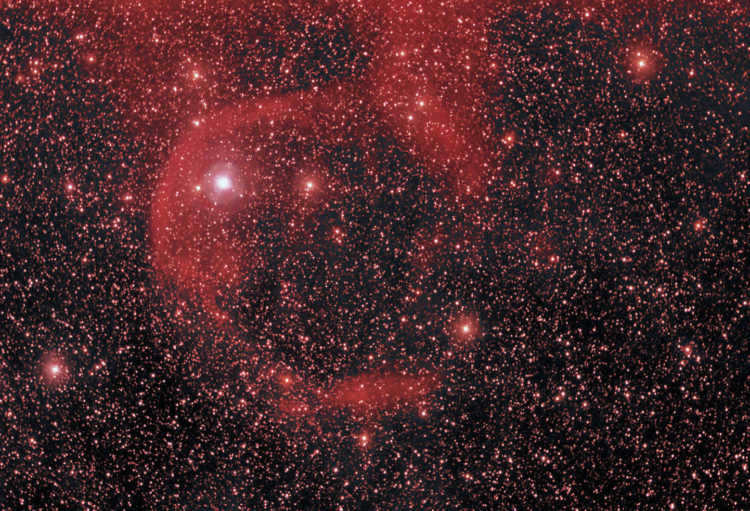
The star’s distance is approximately 7,000 light years, and despite this vast distance, it can still be seen without the aid of a telescope. This star ranks as the third most luminous in the constellation Giraffe, with Beta Giraffe and CS Giraffe holding the first and second positions, respectively.
Orion’s Zeta
Alnitak, also known as Orion’s Zeta, is the brightest O-class star in the constellation Orion. It has a visual stellar magnitude of +1.72 (ranging from highs of +1.72 to lows of +1.79) and is the leftmost star in Orion’s Belt asterism. Alnitak is located approximately 800 light-years away and has a luminosity of around 35,000 times that of the Sun.
Tao of the Enormous Canine
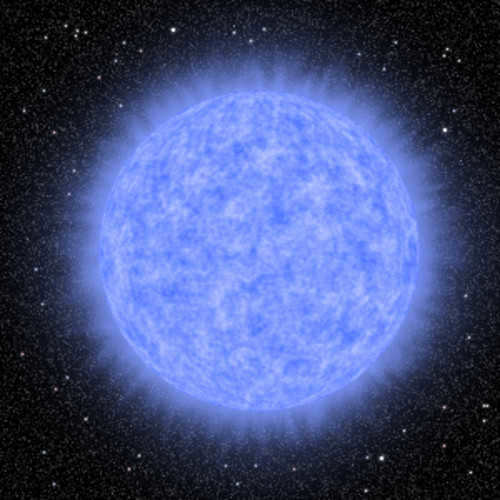
Tau of the Big Dog is a binary star system located in the constellation Canis Major. It is the most luminous star in the scattered star cluster NGC 2362, which is situated approximately 3,200 light-years away from Earth. The primary star, Tau of the Big Dog, is a blue supergiant of spectral class O and has an apparent magnitude of +4.37m. The star system consists of at least five components. In a simplified model, Tau of the Big Dog can be considered as a triple star. The two primary stars have apparent magnitudes of +4.4m and +5.3m, and they are separated by an angular distance of 0.15 seconds. The third star, which has an apparent magnitude of +10m, is located 8 angular seconds away from the inner pair and orbits them with a period of 155 days.
Zeta Korma, also known as Naos, is the dominant star in the Korma constellation. This massive blue star shines with a luminosity equivalent to 870,000 times that of the Sun. Zeta Korma’s mass is an impressive 59 times greater than that of our Sun, and it belongs to the O9 spectral class.
When equipped with a telescope, it becomes possible to observe up to 2 billion stars with a magnitude of up to 21. The Harvard spectral classification system organizes these stars based on their decreasing temperature. The classes are assigned letters from the Latin alphabet, including O, B, A, F, G, K, and M.
The color of a star’s outer layers serves as a useful indicator of its temperature. Hot stars in the O and B spectral classes appear blue, while stars like our Sun (which falls into the G2 class) have a yellow hue. Stars in the K and M classes, on the other hand, display a red coloration.
The brightness and coloration of stars
All stars possess different colors. They can be blue, white, yellow, yellowish, orange, or red. For instance, Betelgeuse is classified as a red star, Castor as white, and Capella as yellow. Stars are categorized by their brightness, which is measured on a scale called stellar magnitude. The highest stellar magnitude is 25. Stellar magnitude does not refer to the actual size of a star but rather to the amount of light it emits and reaches Earth. Stellar magnitudes can be expressed as fractions or negative numbers. This scale is based on how the human eye perceives light. The ancient Greek astronomer Hipparchus (180-110 BC) divided stars into different magnitudes based on their apparent brightness. Hipparchus assigned the first stellar magnitude to the brightest stars and considered the stars with the second stellar magnitude to be slightly fainter (approximately 2.5 times). Stars with a magnitude 2.5 times dimmer than those with the second magnitude were categorized as stars with the third magnitude, and so on. The sixth stellar magnitude was assigned to stars that are barely visible to the naked eye.
It was observed that stars of the sixth magnitude appeared fainter than stars of the first magnitude by a factor of 2.55. To simplify the comparison of stellar magnitudes, the English astronomer N. K. Pogsoy (1829-1891) suggested in 1856 that stars with a brightness 100 times fainter than those of the first magnitude be classified as stars of the sixth magnitude. Since stars are located at varying distances from Earth, it would be more convenient to compare their magnitudes if they were all at the same distance.
The absolute stellar magnitude, denoted by M, refers to the magnitude a star would have at a distance of 10 parsecs. On the other hand, the apparent stellar magnitude, denoted by m, represents the magnitude as observed from Earth.
The outer layers of stars, which emit radiation, are primarily composed of hydrogen, with helium being the second most abundant element. Other elements make up a small portion of their composition.
Stars’ Temperature and Mass
The surface temperature of a star can be determined by its spectral class or color. Since stars radiate like black bodies at their respective temperatures, the amount of energy emitted per unit of surface area can be calculated using the Stefan-Boltzmann law.
Stars can be classified based on their luminosity, temperature, color, and absolute stellar magnitude, as shown in the Hertzsprung-Russell diagram:
- Main sequence (e.g., the Sun, a yellow dwarf)
- Supergiants (large in size and high in luminosity, such as Antares and Betelgeuse)
- sequence of red giants
- dwarfs
- subdwarfs
- blue-white sequence
This classification is also based on the age of the star.
The following types of stars are identified:
- ordinary (like the Sun)
- binary (like Mizar and Albcor) which are further divided into:
- (a) visual binaries, where their duality can be observed through a telescope
- (b) multiple systems, which consist of more than 2 but less than 10 stars
- (c) optical binaries, where the apparent proximity of the stars is due to a chance alignment in the sky
- (d) physical binaries, where the stars orbit around a common center of mass under the influence of mutual gravitational forces
- f) Eclipse-doubles refer to stars that block each other due to their mutual rotation;
New stars are stars that have existed for a significant period of time before suddenly igniting. These stars experience a rapid increase in brightness, with their luminosity growing by a factor of 10,000 in a short span of time (resulting in a change in stellar magnitude from 7 to 14).
Supernovae are stars that were previously invisible in the night sky but suddenly undergo a burst of flames, causing their brightness to increase by a factor of 1,000 compared to normal new stars.
Pulsars are neutron stars that form as a result of a supernova explosion.
Based on data regarding the total number of pulsars and their lifespan, it is estimated that an average of 2-3 pulsars are born per century, which roughly aligns with the frequency of supernova explosions in our galaxy.
Evolution of stars
Stars, like all natural bodies, undergo changes over time. They are born, go through a process of evolution, and eventually reach the end of their life cycle. In the past, astronomers believed that it took millions of years for a star to form from the gas and dust present in interstellar space. However, recent observations have challenged this belief. In particular, photographs taken of a section of the Great Orion Nebula have shown the rapid formation of a small cluster of stars over just a few years. In 1947, three star-like objects were visible in this region. By 1954, some of these objects had elongated shapes, and by 1959, they had completely separated into individual stars. This remarkable series of images provided humanity with the unique opportunity to witness the birth of stars in real time.
There are many regions in the sky where the necessary conditions for the appearance of stars are present. By examining photographs of hazy areas within the Milky Way, scientists have been able to identify small, irregularly shaped black spots known as globules. These globules are massive collections of dust and gas and contain dust particles that strongly absorb light from the stars located behind them. The size of these globules can be incredibly large, spanning several light-years. Despite the low density of matter within these clusters, their overall volume is significant enough to facilitate the formation of small star clusters with masses comparable to that of the Sun.
The descent of matter may span several centuries. Initially, it occurs gradually and leisurely due to the relatively weak gravitational forces pulling the particles towards the core. As time passes, the globule shrinks and the gravitational field intensifies, causing the descent to accelerate. However, the globule itself is immense, measuring at least a light-year in diameter. Consequently, the distance from its outer perimeter to the core could exceed 10 trillion kilometers. If a particle originating from the outer edge of the globule initiates a descent towards the core at a velocity slightly below 2 km/s, it will only reach the core after a staggering 200,000 years.
The lifespan of a star is determined by its mass. Stars that are smaller than the Sun are extremely efficient in using their nuclear fuel and can continue to emit light for billions of years. As stars like our Sun, with a mass no greater than 1.2 times that of the Sun, age, their outer layers slowly expand and eventually detach from the star’s core. The result is a compact and hot white dwarf in place of the once giant star.

Stars are among the most scorching entities in the cosmos. The intense heat emitted by our Sun is what has made life on Earth viable. However, the source of this powerful stellar heating has long eluded scientific understanding.
What is the source of heat in a star?
The origin of the intense temperature in a star is found internally. It is not solely determined by the star’s makeup – in fact, all of the heat of the star is generated from within. The core serves as the scorching core of the star, housing the thermonuclear fusion reaction, which is the most potent form of nuclear reactions. This reaction serves as the primary source of energy for the entire star – the heat emanates from the core and then spreads outwards into the vastness of space.
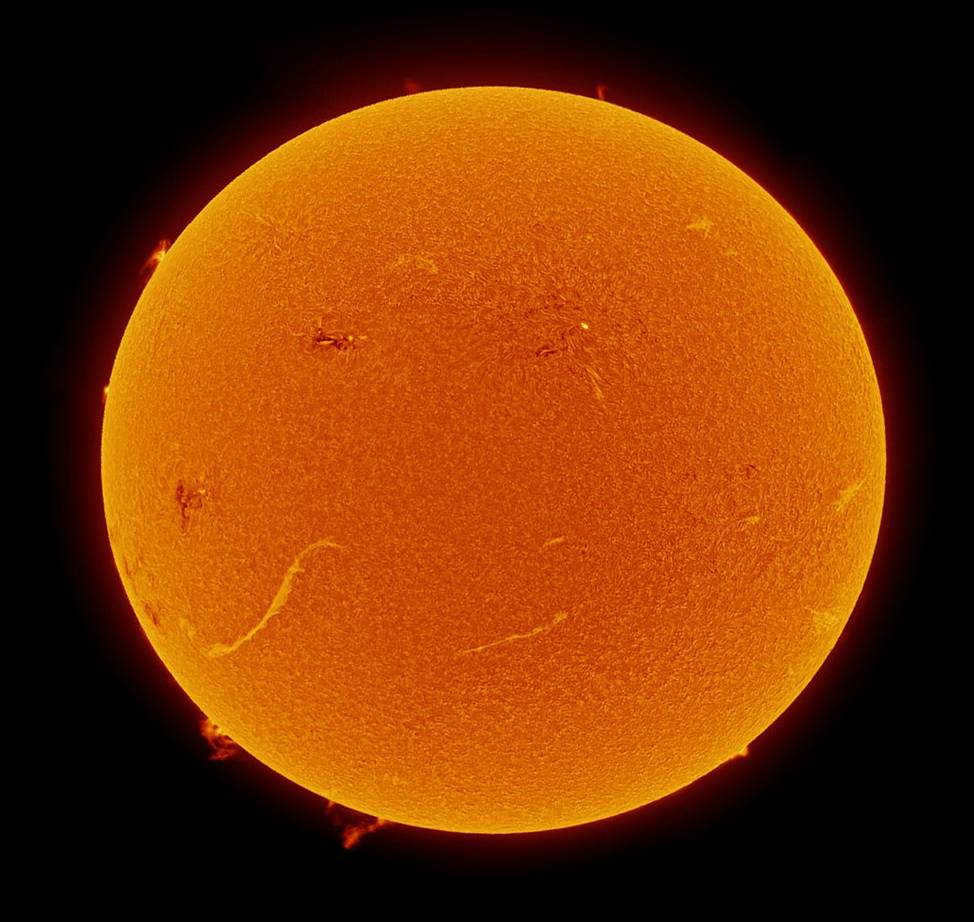
As a result, the temperature of a star can vary significantly depending on the location at which it is measured. For instance, the temperature at the core of our Sun can reach as high as 15 million degrees Celsius, whereas on the surface, in the photosphere, it drops to 5 thousand degrees.
However, there is also the stellar corona, which is the uppermost part of a star’s atmosphere. Its temperature is unusually high compared to the lower layers, reaching between 900 thousand to 1 million degrees Celsius in the case of the Sun. The exact cause of this temperature jump is still unknown to scientists, but it is believed to be related to the Sun’s magnetic field. This magnetic field plays a significant role in determining the final temperature of the star’s surface, but more research is needed to fully understand its influence.
The Sun is the most prevalent star in the cosmos, thus its temperature is representative of the majority of observable stars. Nonetheless, there exist hotter stars: the scorching surface of blue supergiant stars like Jeta in the constellation Corma reaches a staggering 200,000 °C! It is truly awe-inspiring to contemplate the immense temperature within their cores – the heat surpasses a hundred million degrees Celsius. Conversely, red giants are cooler – their photosphere is heated to a mere 2.5-3 thousand degrees Celsius.
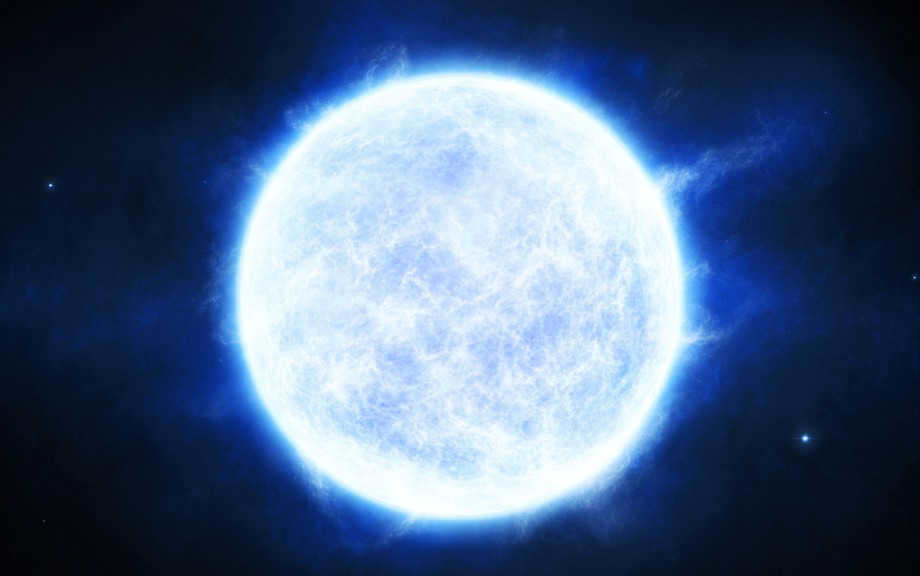
It can be observed that the temperature of a star directly influences its color. The color of a star becomes bluer as its temperature increases. The color-temperature relationship is crucial in classifying stars into spectral classes. It is also an important factor in the positioning of luminosity in the Hertzsprung-Russell diagram. By analyzing the color-temperature relationship, stars with similar characteristics can be identified, and the age of a star can be determined.
What causes the vast variation in the temperature of stars?
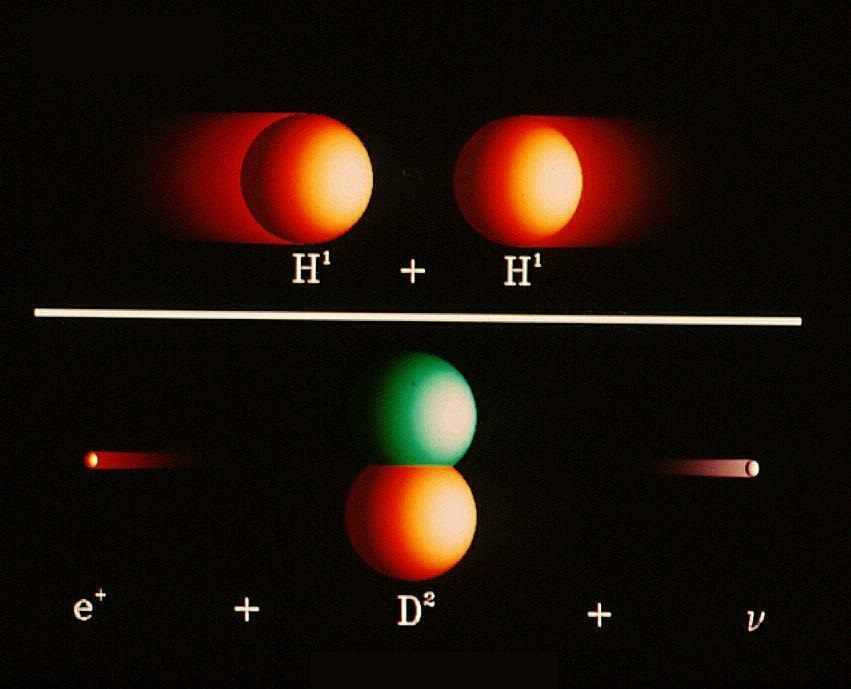

The initial bonding of hydrogen atoms is the first stage in the process of nuclear fusion.
Undoubtedly, the disparities in temperature between the core and surface of a star are astounding. If the entirety of the Sun’s core energy was evenly distributed throughout the star, the surface temperature of our celestial body would reach several million degrees Celsius! Equally remarkable are the variations in temperature among stars of different spectral classes.
The key point is that a star’s temperature is determined by two primary factors: the level of energy emitted by its core and the surface area from which it radiates. Let’s examine these factors more closely.
While the core may reach temperatures of up to 15 million degrees, not all of the energy is transferred to surrounding layers. Only the heat generated from the thermonuclear reaction is emitted. The energy from gravitational compression, although powerful, remains within the core. As a result, the temperature of the outer layers of the star is solely influenced by the strength of the thermonuclear reactions in the core.
These variations can occur both in terms of quality and quantity. If the core is sufficiently large, it can “burn” more hydrogen. This process provides energy for young and mature stars similar in size to the Sun, as well as blue giants and supergiants. In contrast, red giants, which are massive stars, not only consume hydrogen but also helium, carbon, and oxygen in their nuclear “furnace”.
Resources on the subject

When heavy element nuclei undergo fusion processes, they generate a significantly higher amount of energy. In a thermonuclear fusion reaction, the excess mass of the fusing atoms is converted into energy. Within the Sun’s proton-proton reaction, 6 hydrogen nuclei with an atomic mass of 1 merge to form one helium nucleus with a mass of 4. In simpler terms, 2 additional hydrogen nuclei are converted into energy. On the other hand, during the “burning” of carbon, nuclei with a mass of 12 collide, resulting in a much greater energy output.
Radiant surface area
However, stars not only produce energy, but they also expend it. As a result, the star’s temperature decreases as it gives off more energy. The amount of energy released is directly related to the surface area available for radiation.
This principle can even be observed in everyday life – clothes dry more quickly when they are spread out on a wide clothesline. Similarly, a star’s surface expands from its core. The denser the core, the higher the temperature, and once it reaches a certain threshold, the intense heat causes hydrogen to ignite outside of the star’s core.
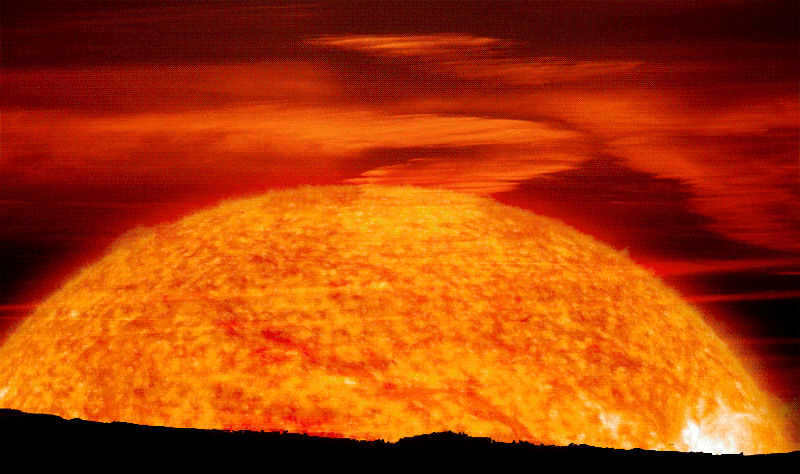
A red-hot giant’s sunrise as seen by the artist
Variations in surface temperature
Another crucial aspect is that different regions on the surface of the same star can exhibit varying temperatures. These differences can be as high as several thousand degrees Celsius! The variation is dependent on how energy is transferred from the star’s core. Astrophysicists identify two primary methods: radiative transfer and convection:
- During radiative transfer, nuclear fusion energy is emitted from the star’s core and travels straight through the stellar matter in the form of rays. This process is efficient in terms of energy conservation but is quite slow. For instance, if the radiative transfer zone is situated near the star’s core, like in our Sun, the rays’ journey can take tens of thousands of years.
- Convection, however, operates on the principle of warm liquids and gases rising to the top and cold liquids and gases sinking to the bottom, which is a well-established natural law. As stars are composed of gas, convection is also observed within them. The matter within a star becomes heated in its hotter layers, causing it to rise to the cooler regions of the star with lower gas pressure. In these regions, the energy derived from within the star is emitted in the form of radiation.
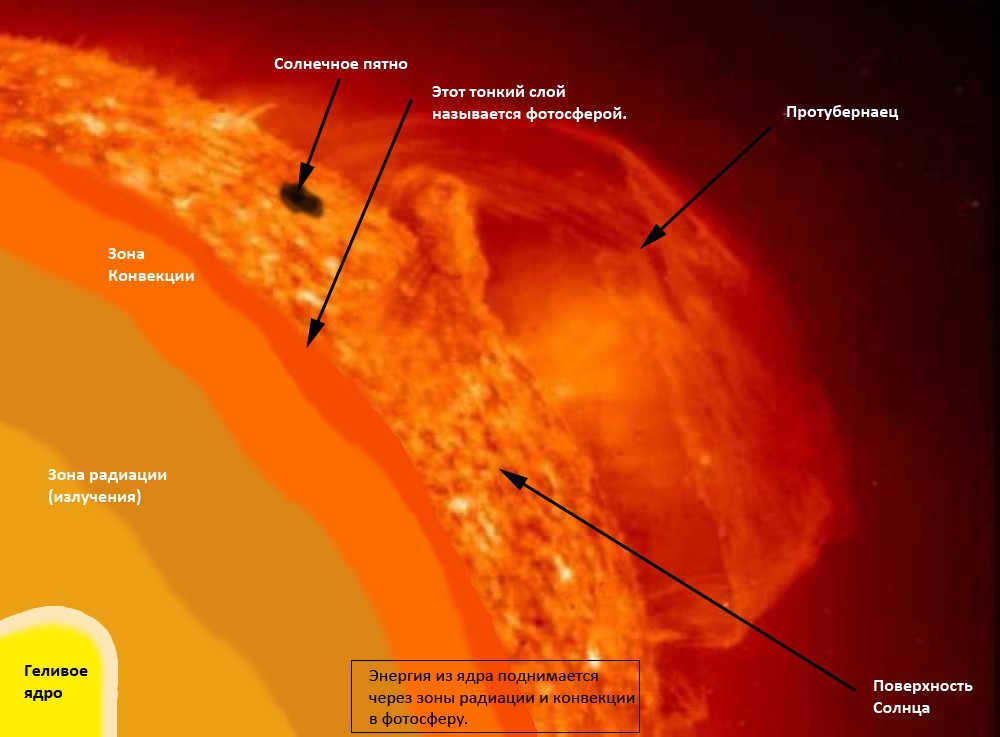
Schematic representation of the energy transfer process in a star similar to the Sun
The positioning of the regions responsible for radiative transfer and convection within a star varies depending on its mass. In stars that are smaller in mass compared to the Sun, convection is the dominant mechanism. On the other hand, in massive stars, heat is transferred from the core to the outer layers primarily through convection, and then further transported to the surface via radiative transfer.
The Sun, however, follows a different pattern: energy from its core is emitted in the form of radiation and subsequently transported to the surface through convective plasma flows. It is in the photosphere that the Sun’s energy is once again converted into light, including the visible spectrum perceivable by the human eye.
Temperature variations on the surface of the Sun are caused by convection, and these variations can be visually distinguished. There are three primary types of temperature variations: flares, spots, and prominences.
- Flares are areas on the Sun that are hot and bright. They have a temperature that is 1-2 thousand degrees Celsius higher than the surrounding surface.
- Spots are cooler and darker areas on the photosphere of the Sun. The temperature at the center of a spot is 2000 °C lower than the normal temperature of the Sun. There is also a surrounding “shadow” that is slightly warmer – it is only 200-500 degrees cooler than the surrounding photosphere.
- Prominences are ejections of material from the interior of stars that extend above the atmosphere of the Sun. While they are not as hot as the corona of the Sun, their temperature can reach up to 15,000 degrees Celsius, which is higher than the temperature of the photosphere.
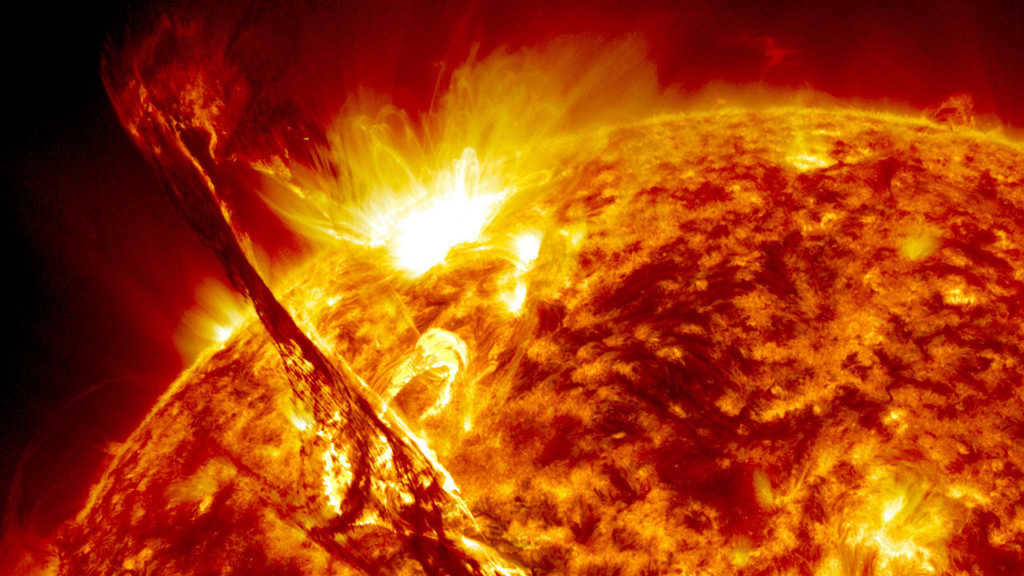
Spots, flares, and prominences are all phenomena that occur on the Sun as a result of the star’s magnetic fields intersecting the photosphere during periods of heightened activity. Flares manifest in regions where magnetic lines of force accelerate convective flows of gases from the Sun’s interior. Prominences, on the other hand, have a similar origin but possess a much narrower zone of magnetic field emergence and stronger magnetic lines. In sunspots, however, the magnetic field hinders the process of thermal transfer, resulting in a dimmer and cooler appearance.





